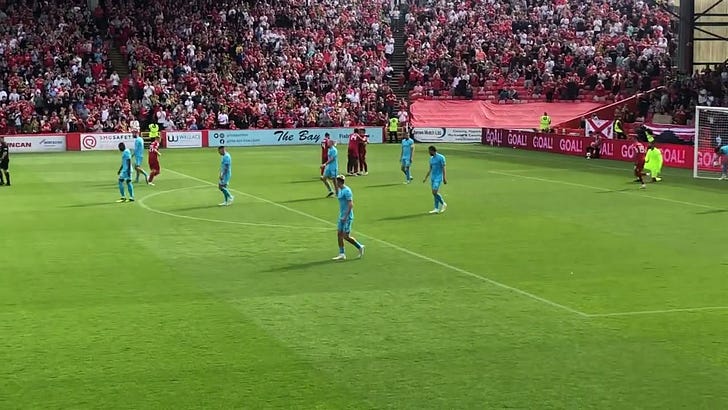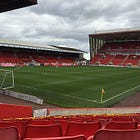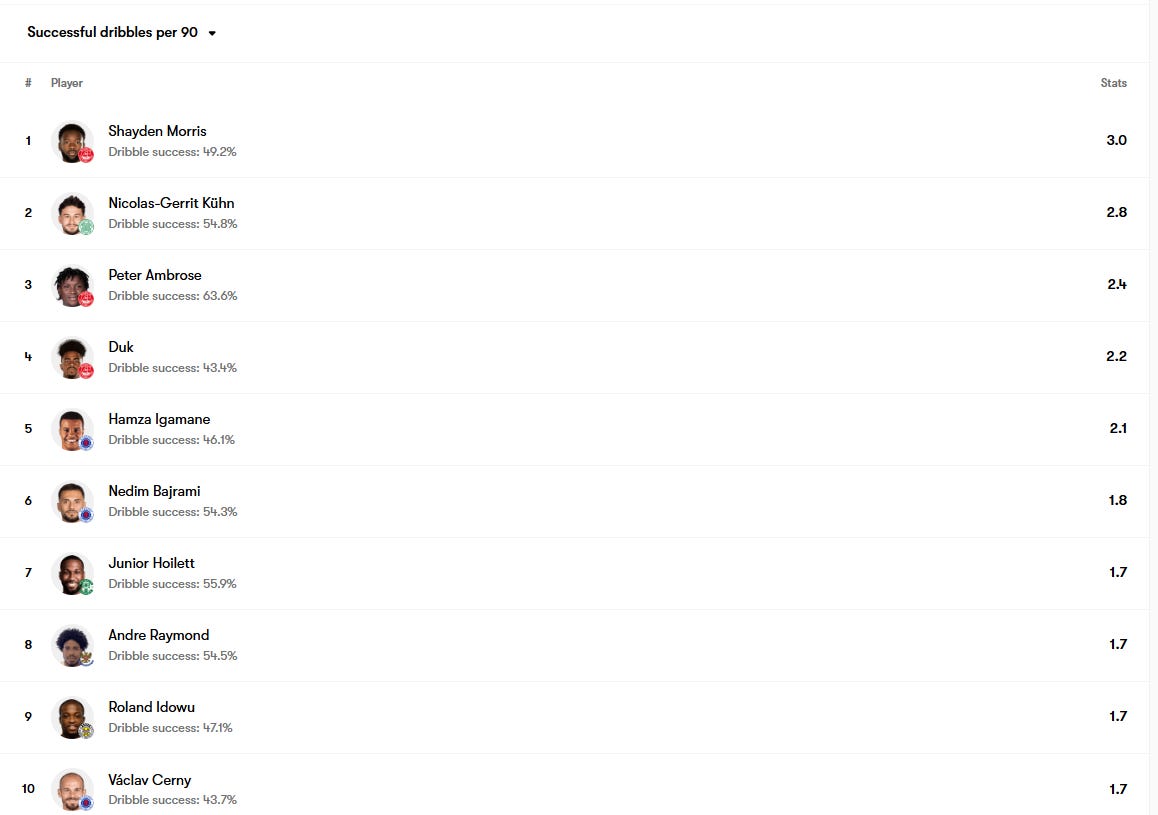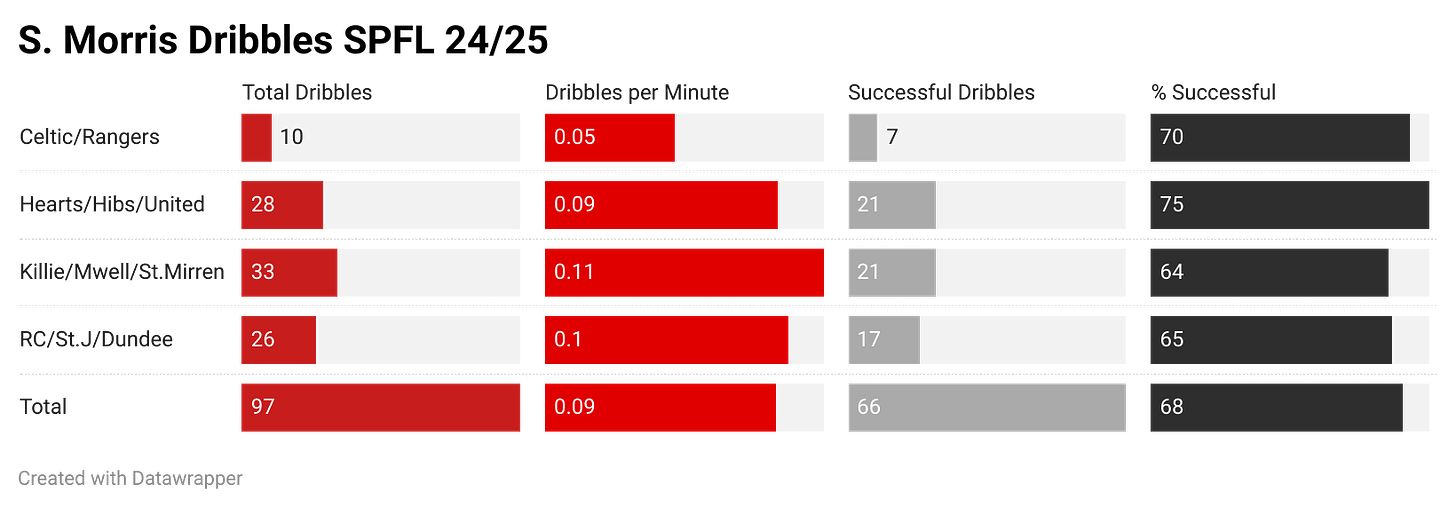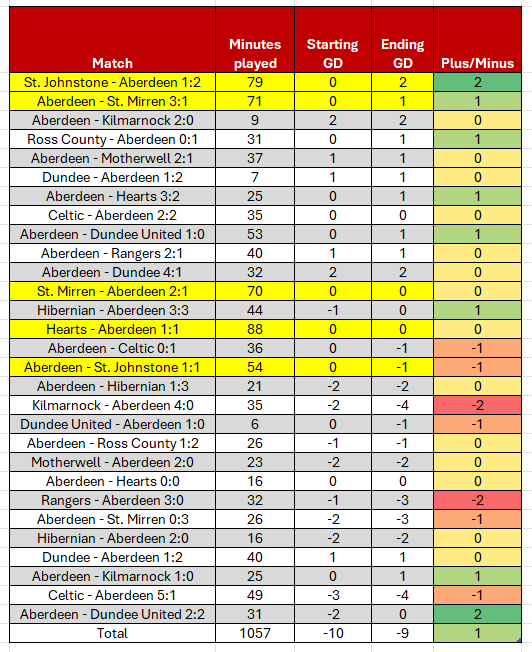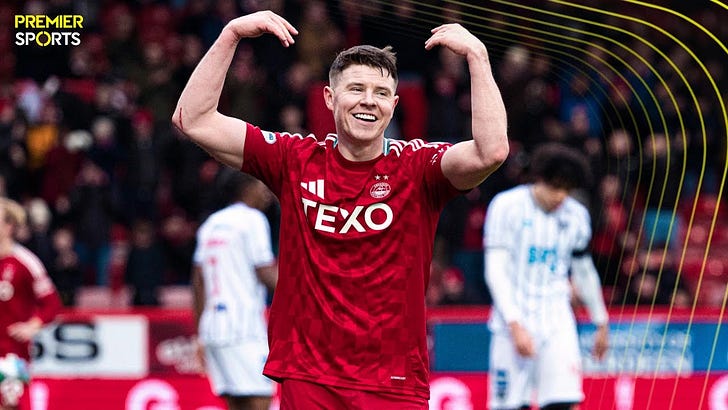It was one year ago this weekend that Neil Warnock announced his departure from Aberdeen after another quarter-final victory in the Scottish Cup. Things have not been perfect in the intervening twelve months, but the club is certainly in a stronger position.
Shayden Morris did not feature in that match. Indeed, following his ignominous hooking after 30 minutes in the peak-Warnock 3-3 draw with Motherwell on Valentine’s Day, he did play again in the league for the rest of the season. There was a twenty-minute cameo in extra-time against Celtic in the cup semi-final, but it seemed like his Aberdeen career might be over.
I had written him off. In a summer post on the Dons recruitment over the previous three seasons, I gave Morris a 1 out of 5 and noted the following:
Still with Aberdeen are the speed merchants Richardson and Morris. Brought in as ‘raw recruits’, neither has been able to develop a first touch and if Thelin can turn them into solid SPFL players, he deserves the freedom of the city for that alone.
I’m not sure who the Lord Provost is these days, but I reckon we can safely say Jimmy has turned Morris into a solid SPFL player. On his day, this season, he is one of the most effective attacking players in the league.
Project 2025
Though Saturday was in the Cup and though the Dons were facing Championship opposition, Morris was outstanding. His two assists took him to eleven for the season, alongside his four goals. But, his game time continues to be limited. Six of those assists have come against lower-league opposition, as have two of his four goals.
There are two main questions regarding Morris right now:
Should he be starting more games? - Is Morris just a ‘one-trick pony’ good for impacting games against tired legs and lower-league opposition or is he an underused attacking weapon that the team can ill-afford to leave on the sidelines?
Should he be offered a new contract? - Shayden’s contract expires in the summer of 2026. Jimmy Thelin, Nuno Almeida, and Steven Gunn need to figure out in the next few months, in my opinion, whether they wish to extend it. Otherwise, having another player run out a contract, especially if he’s performing well, would not reflect well on a club leadership relying on a successful player-trading model.
I’ll try and dig into both questions over the next two posts. Part one will be more focused on numbers from this season, and in part two (hopefully with a start against St. Johnstone to review), I’ll look more at the tactical side.
Brass Tacks
I’m only going to look at Morris’s SPFL performances. So his numbers take a hit, but we get a better context in which to view his achievements.
Minutes Played: 1057
Games Started: 5
Goals Scored: 2 (1.37xG)
Assists: 5 (2.0xA)
I pulled the above radar from the wonderful Ben Grifis, who has several wonderful tools on his website. This ranks Morris compared to players in his position across a number of metrics. Note that the sample size is only 17 players who fit into this positional category.
On those blue bars, Morris is considered in the elite top 10% compared to other Scottish Premiership wingers. Especially pertinent are those at 3 o’clock: Progressive carries, acceleration with the ball, and dribble success. Indeed, FotMob has Morris as completing the most successful dribbles per 90 in the league, with 3.0 per 90.
The areas in red indicate where he needs to improve and what may be related to Thelin’s reluctance to have him play from the start, i.e., tackles and interceptions, defensive actions, and then, on the finishing side, shots and non-penalty xG.
Dribbling
Progressing the ball in 1v1 situations is Morris’s major strength, and as mentioned, he sits number one in the league for successful average dribbles per 90. What is a successful dribble? I took the data from FotMob, which I believe comes from Opta. According to this glossary:
“A successful dribble means the player beats the defender while retaining possession, unsuccessful ones are where the dribbler is tackled”
Fairly simple, right?
There doesn’t seem to be a minutes-played limit on this, so Big Pete sneaks into the top three on the FotMob data. (I had a little look at Ambrose’s data, and it’s not that bad. Worth keeping an eye on?)
Does this vary against the level of opponent Morris faces?
I broke his number of dribbles down by four tiers of opponents within the SPFL.
We can see a noticeable difference in the number of dribbles Morris attempts against the top two sides. However, his success rate is still pretty high, he just attempts fewer dribbles in those games. Probably because Aberdeen have significantly less possession.
Otherwise, his numbers are fairly consistent across the board. 7 out of 10 times he runs with the ball, he gets past his man. Not bad if you ask me.
Plus Minus
This is a fairly rudimentary assessment, but given his reputation as an impact sub, I wanted to look at how the team’s goal difference was affected by Morris’s time on the pitch.
Overall, he’s sitting at a positive +1 GD. It doesn’t sound like much, but the team as a whole is -8, although he only averages around 36 minutes per game. The yellow highlighted matches Morris started in. Aberdeen’s record in those games is two wins, two draws, and one defeat. He notched up two assists in those matches. In only one of those games have Aberdeen been behind when he was substituted.
Goals and xG, Assists and xA
Those with keen memories will note that one of Morris’s assists mentioned above came against St. Mirren. Judge for yourself whether that was intended (video via Paul Donaldson).
Goals and Assists Breakdown
He’s slightly overperforming on the goals front, but it’s a very small sample size (2 goals to 1.34xG). Both goals did come against the top two teams in the league. And yes, the Dons were 4-0 down at Parkhead, but Celtic have an outstanding home defensive record and would not have been keen to concede.
I found it hard to get the numbers for the expected assist on each goal (xA). In total, Morris’s data from FotMob has an expected assists for the season of two versus an actual of five. So he is over-performing there.
What the data doesn’t show (and this may be the case for plenty of others) is the number of additional goals that his play has had a major impact on. As noted in last week’s post, I have Morris majorly responsible for a couple of additional goals: Gueye vs. Motherwell and McGrath vs. Hibs.
Looking at the data from Wyscout used by Ben Grifis, Morris ranks in the bottom 25% amongst wingers for second assists per 90, but is third for third assist per 90 behind Kuhn and Maeda. I appreciate that was a confusing sentence. Effectively, he’s contributing to goals not just with the final pass but also in the build-up.
In summary, some over-performance on the assist front, but given his limited minutes, it’s still a pretty impressive turnout, with an expected assist average of 0.21 per 90 minutes. That puts him 22nd in the league (Luke McCowan is #1 at 0.4). We’d have to see if this evens out in the longer run, were he to see more time on the field.
Defensive Side of the Ball
“Shayden has made a journey from the beginning of the season to be more complete as a player. He has his skills, his pace, one against one, his crosses. But he also takes more responsibility for the whole result of the game, he helps the defenders and is trying to be stronger in the duels. I think you can see he’s making more and more impact as a player.”
Jimmy Thelin speaking after Queen’s Park win (www.afc.co.uk)
The words of the manager which hint at the biggest factor for Morris not seeing the pitch more often. I think this certainly warrants some further tactical study.
In the meantime, here are six of the key defensive metrics published by FotMob for Morris, Keskinen, Gueye, and McGrath. Okkels has probably not racked up enough minutes thus far to make a fair judgement.
McGrath is the outlier in terms of winning the ball back. That’s not too surprising, as not he’s not an out-and-out wide man or forward, and well, he’s a pretty good midfielder. Gueye dominates the aerial duels but is unspectacular elsewhere. What’s most surprising is that Morris is ahead of Keskinen in every single metric.
There are some caveats. Morris is a smaller sample size and the Finn did play a lot of minutes throughout the bad run. We’re also only showing on-ball event data. Keskinen does always appear to work hard to press opponents but there’s no real way for me to quantify that without more sophisticated data (which the club may have).
But there’s some food for thought there.
End of Part One
I’ll save my opinion on the two questions I raised earlier for next week. Some tactical elements need consideration. In terms of the data, however, I have tried my best to look at a few different topics:
Does Morris only impact games against weaker teams? This doesn’t appear to be the case based on his dribble success. His volume is down vs the top two, but it is to be expected and is probably balanced off with his counter-attacking threat.
Do Aberdeen suffer defensively when Morris is on the field? No clear answer in terms of scorelines to suggest that is the case. On-ball defensive data does not point to him being any worse defensively than Keskinen. And certainly enough to want to take the risk based on the offensive upside.
Is Morris overperforming? Assist data would seem to suggest so, but the baseline numbers are not bad, given his time on the field. Goals-wise, he’s about where he should be.
I hope he plays this Saturday.
COYR


